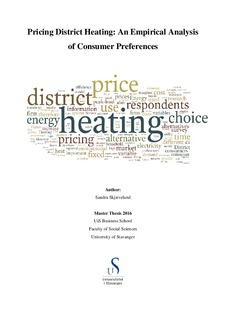| dc.contributor.author | Skjæveland, Sandra | |
| dc.date.accessioned | 2016-09-30T10:26:23Z | |
| dc.date.available | 2016-09-30T10:26:23Z | |
| dc.date.issued | 2016-06-15 | |
| dc.identifier.uri | http://hdl.handle.net/11250/2412204 | |
| dc.description | Master's thesis in Economic analysis | nb_NO |
| dc.description.abstract | Increased awareness and concern for climate issues in recent years has brought about greater support for environmentally friendly solutions in the energy sector. This has put pressure on the sector to adapt to renewable energy sources. District heating has emerged as an important contributor to achieving climate policy goals because of its potential to protect the environment, increase energy efficiency and enhance energy security for the future. As a relatively new heating option, district heating has potential for future growth in Norway as a step towards a more sustainable development in the energy sector.
This thesis adopts a discrete choice experiment approach to address the research objective of identifying households’ and firms’ preferences and attitudes towards district heating. More specifically, preferences towards different types of district heating pricing are explored based on survey data from households and firms in Southern Rogaland in Norway. Lyse Neo AS is the region’s leading provider of district heating. Thus, the empirical analysis seeks to bring forth useful information that can assist Lyse Neo AS in price-making decisions.
The current method of pricing district heating is commonly based on linear pricing methods. This thesis explores the potential to depart from the current strategies towards alternative forms of pricing based on dynamic pricing. Respondents in this study were faced with two choices between three pricing alternatives, one linear (fixed price) and two dynamic prices (time of use price and peak-load price). The results from the empirical analysis indicate that there exist preferences for the dynamic pricing options. To investigate the preference of environmental considerations in relations to heating decisions, approximately half of respondents received information about environmental and system benefits associated with the dynamic pricing alternatives. The overall results show that among the respondents receiving the information, there was a clear preference for the time of use price. Respondents not receiving the information were shown to prefer the fixed price in the first choice and the time of use in the second choice.
Several variables were identified to impact the choice of preferred pricing method. For instance, it was found that higher education increased the probability of choosing the peak-load price compared to the fixed price. In addition, monthly electricity use and expenditures, as well as household size had significant impacts on the choice probabilities. | nb_NO |
| dc.language.iso | eng | nb_NO |
| dc.publisher | University of Stavanger, Norway | nb_NO |
| dc.relation.ispartofseries | Masteroppgave/UIS-SV-HH/2016; | |
| dc.subject | økonomi | nb_NO |
| dc.subject | administrasjon | nb_NO |
| dc.subject | økonomisk analyse | nb_NO |
| dc.title | Pricing District Heating: An Empirical Analysis of Consumer Preferences | nb_NO |
| dc.type | Master thesis | nb_NO |
| dc.subject.nsi | VDP::Social science: 200::Economics: 210::Economics: 212 | nb_NO |
